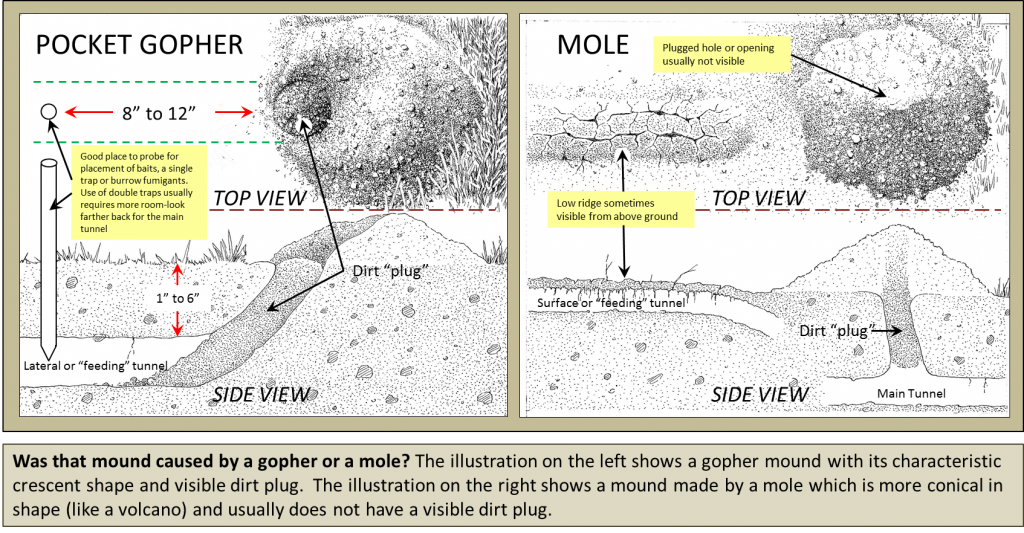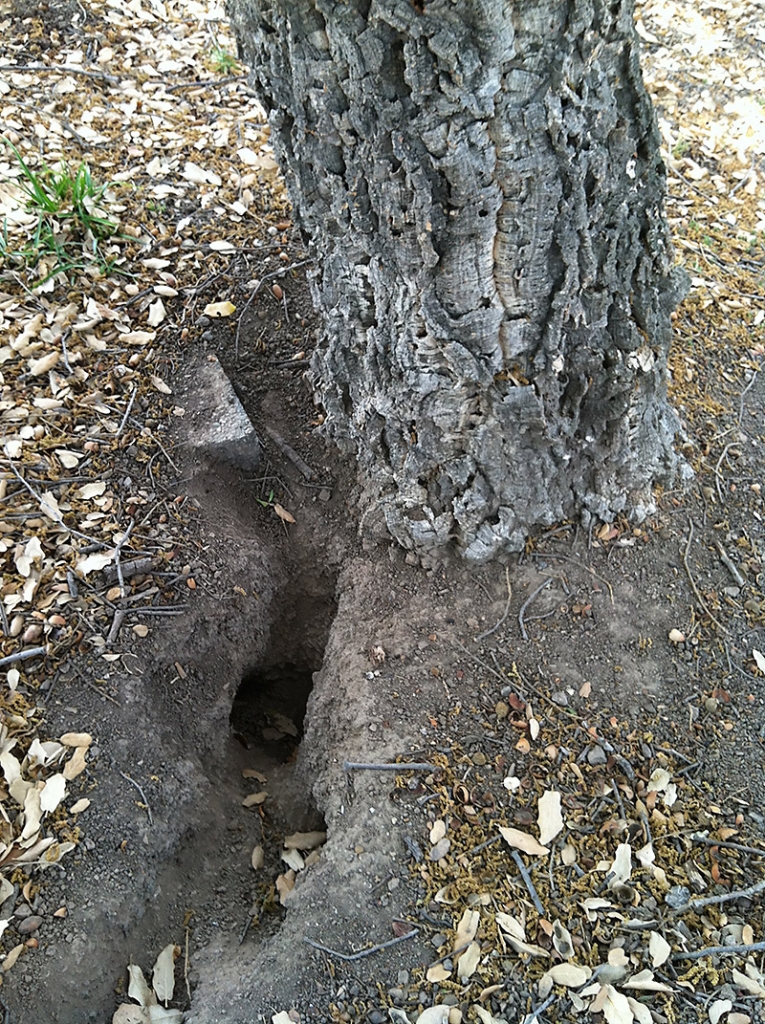Traps
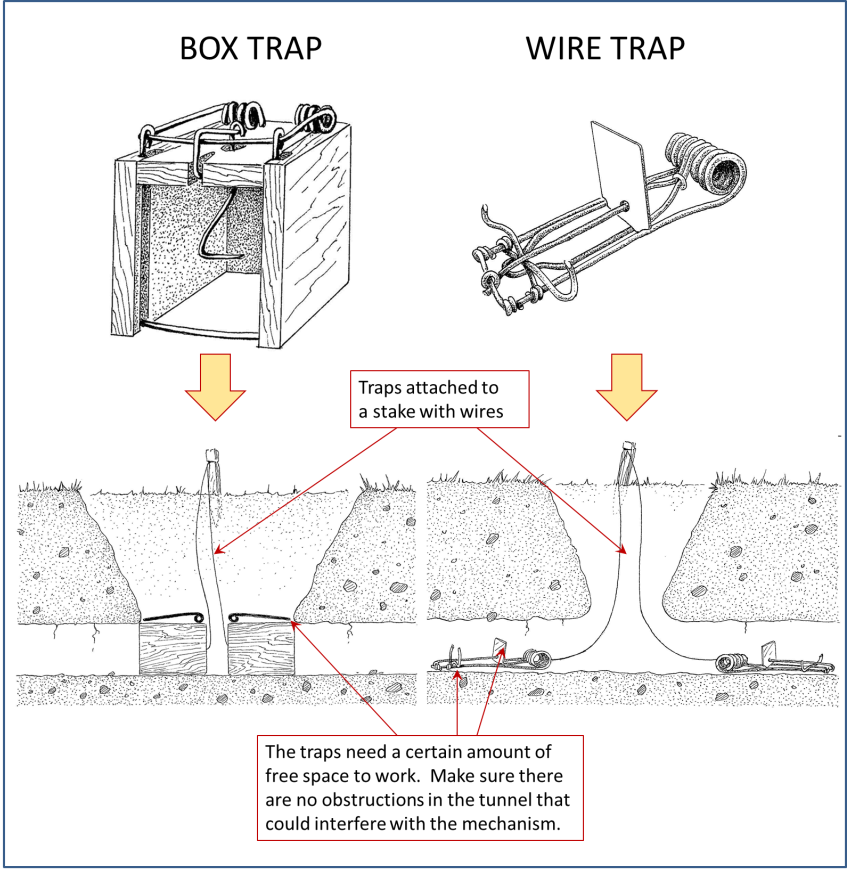
Trapping can be an effective method for gopher control in some situation, but the traps must be properly set or they won’t work!
All rodent traps fall into two basic groups which are those that kill the rodent and those that catch them alive. Traps are a little more selective than glue boards since in most cases animals are lured to them with bait. However, the kill types still pose a hazard to non-target animals, especially if something universally attractive is used as bait like peanut butter. Some degree of protection for birds can be achieved by deactivating traps or bringing in glue boards during the day when birds are active and rodents generally are not. Glue boards and traps all pose the problem of disposing of the rodents once trapped.
Rodenticides
Rodenticides, including anticoagulants, are a valuable tool but their use outdoors should only be done by a certified professional using extreme care. They should never be used in an attempt to compensate for weak sanitation or poor cultural practices. Facilities managers considering using a rodenticide outdoors should contact an ACWM biologist who can confirm the use contemplated is appropriate and safe.
Native Burrowing Rodents
The burrowing rodents most likely to be encountered in the urban areas of Los Angeles County are pocket gophers, California ground squirrels and meadow mice (Voles). Moles will also be included in this section, even though they are not a rodent , because their tunneling and mounds are similar to and often confused with gophers’. With all of the burrowing rodents, it is frequently possible to achieve an acceptable level of management without pesticides.
Pocket Gophers
Pocket gophers (gophers) are an extremely common native mammal. They spend most of their time underground consuming a wide variety of plant roots, bulbs and sometimes even bark. Gophers can become damaging in many situations especially small gardens, areas with new plantings and in turf. They are less of a problem in areas with established plants or in natural areas. The damage probably most closely associated with gophers is the extensive tunneling and mound building in turf. The shallow tunnels can be a trip hazard and the dirt mounds can ruin the aesthetics of a lawn as well as kill the grass underneath them creating bare spots allowing weeds to invade.
Gophers are not easily scared and will investigate any sort of disturbance or thing within their burrows including a trap placed there. For this reason, they can be fairly easy to trap making this control method a viable option for small populations. All of the commercially available traps work, but at least one study suggests the wire-type might work a little better than the box-type and they are also easier to set.
None of the following have been scientifically proven to be effective against gophers when placed in or near burrows:
- Gas cartridges (“smoke bombs”)
- Water hoses
- Chewing gum
- Dog or cat feces
- Laxatives
- “Frightening” devices like vibration producing windmills and ultrasonic wave generators
It is possible to manage gopher damage using pesticides. The materials available are treated baits and burrow fumigants. If baits are used, they must be very carefully placed within the burrow system or the gopher won’t be able to find them. Moist soil conditions can spoil the bait in as little as a day rendering it ineffective. For most of the treated baits, only a small amount of kernels represent a lethal dose for a gopher so even less will kill a bird. For this reason, applicators must ensure that absolutely no bait remains above ground – not even a single kernel.
By far the most effective material for gopher control, especially in large turf areas, is the burrow fumigant aluminum phosphide. Aluminum phosphide is a potentially dangerous Category I pesticide requiring a special permit to use and possess, a site-specific fumigation management plan, posting of the property, a 24-hour Notice of Intent for some uses, among other requirements. Anyone contemplating using aluminum phosphide should first contact an ACWM biologist for advice. Gophers are just one reason why serious consideration should be given to replacing turf with more pest resistant and drought tolerant landscaping.
Moles
Moles are not actually rodents but insectivores. Their tunnels and mounds bear a resemblance to gophers which are a way more common and damaging pest. Moles’ diet consists mostly of subsoil invertebrates like earthworms and grubs. The only significant plant “damage” is from the mounds and raised tunnels. Unless the tunnels are causing a trip hazard or the mounds are ruining prized turf, mole damage can simply be tolerated in many cases. The raised tunnels are frequently only used once by the moles that made them; therefore, walking on them can often “repair” the damage. A few deft moves with a shovel or rake each day can prevent the mounds from killing the grass underneath them. If control is needed, there are traps available but they require considerably more skill to set than gopher traps. Chemical control of moles includes poison bait and burrow fumigants. Only limited success can be expected from the former and the latter involves the use of aluminum phosphide which should only be used following a review by an ACWM biologist.
Ground Squirrels
California Ground Squirrels are probably Los Angeles County’s most destructive vertebrate pest. They have the ability to flourish in disturbed habitat reaching population densities many times the level supported by natural areas. Extensive burrowing by ground squirrels can disfigure landscaping, expose tree roots to desiccation, completely cover grass and small plants, weaken earth berms and undermine buildings, roads, culverts, drains, and driveways.
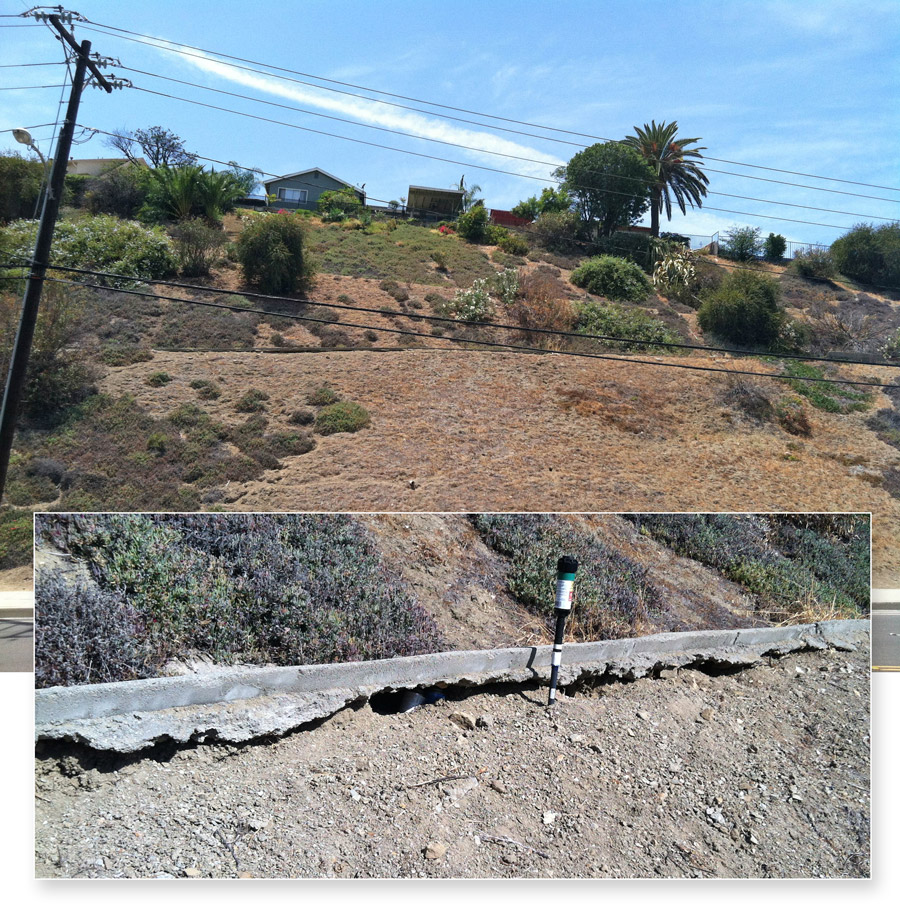
The integrity of this slope in Diamond Bar is maintained by carefully engineered water runoff. In this case, it is being compromised by extensive ground squirrel burrows which are undermining the V-Ditch.
High populations of ground squirrels next to wild areas can degrade the area’s natural biodiversity by burrowing, eating native plants and even predation on the eggs of ground-nesting birds*. Ground squirrels are also a health risk posing a very real danger of plague-if unusual numbers of dead squirrels are observed; the Department of Public Health, Environmental Health Division should be notified.
Ground squirrels are greedy consumers of food leftovers resulting from poor sanitation and very quickly become habituated to food handouts, both of which will almost certainly result in very high populations. For this reason, good sanitation is critical to prevent excessively large populations in areas prone to ground squirrels. Did you know that it is against the law to intentionally feed ground squirrels in Los Angeles County**?
As mentioned previously, ground squirrels prosper in disturbed areas and many parts of Los Angeles County are prone to high populations. In these and other areas, there is no practical way of excluding ground squirrels using fencing or any other type of barrier.
The following are some general action thresholds for deciding when to attempt direct control of ground squirrels.
- Anytime the burrows threaten to undermine roads, driveways or foundations
- When burrows threaten to damage infrastructure designed for drainage control or to channel, hold back or store water such as concrete V-ditches, levees and dirt berms
- High or increasing ground squirrel populations are detected near areas frequented by County employees or visitors such as parking lots, picnic areas and well-used trails
- Degradation of landscaping becomes intolerable
Trapping is a practical way of managing small to moderate populations of ground squirrels. As with other rodent traps, there are live-catch and kill-types available. Use of the former is accompanied with the problem of what to do with the trapped squirrels. It is not legal to release or “relocate” ground squirrels into another area. The kill-type traps include the box and wire (Conibear) kind.
When any Conibear trap is set on publicly owned land or land expressly open to public use, the law requires posting of signs at every entrance and exit to the property indicating the presence of Conibear traps and at least four additional signs posted within a radius of 50 feet of the trap, one in each cardinal direction, with lettering that is a minimum of three inches high stating: “Danger! Traps Set For Wildlife. Keep Out.” Signs shall be maintained and checked daily.
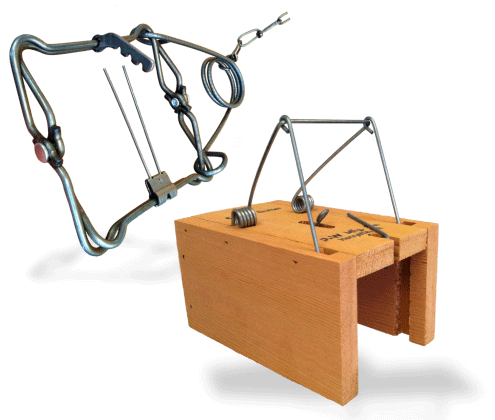
The two main types of ground squirrel kill traps are the wire -type like the Conibear 110 above (shown not set) and the box-type. Both work well but the box trap is easier to set and bait. The Conibear also has some pretty serious sign posting requirements (see text) which limits their use in many areas.
A good bait for the box trap is a slice of apple stuck on the trigger. The Conibear is probably most often used without bait by placing over the burrow entrance as shown in the inset photo below.
The Conibear is a very powerful trap and should only be used in areas not accessible to children, pets or non-target wildlife. Both traps need to be secured. Watch your fingers!
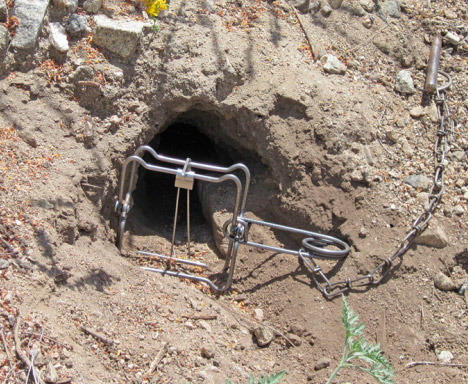
* Salmon, T.P.and W.P. Gorenzel, GROUND SQUIRREL: Integrated Pest Management for Home Gardeners and Professionals, University of California Agriculture & Natural Resources, http://www.ipm.ucdavis.edu/PMG/PESTNOTES/pn7438.html (February 2010)
** Los Angeles County Code, Title 10, Section 10.84.010


